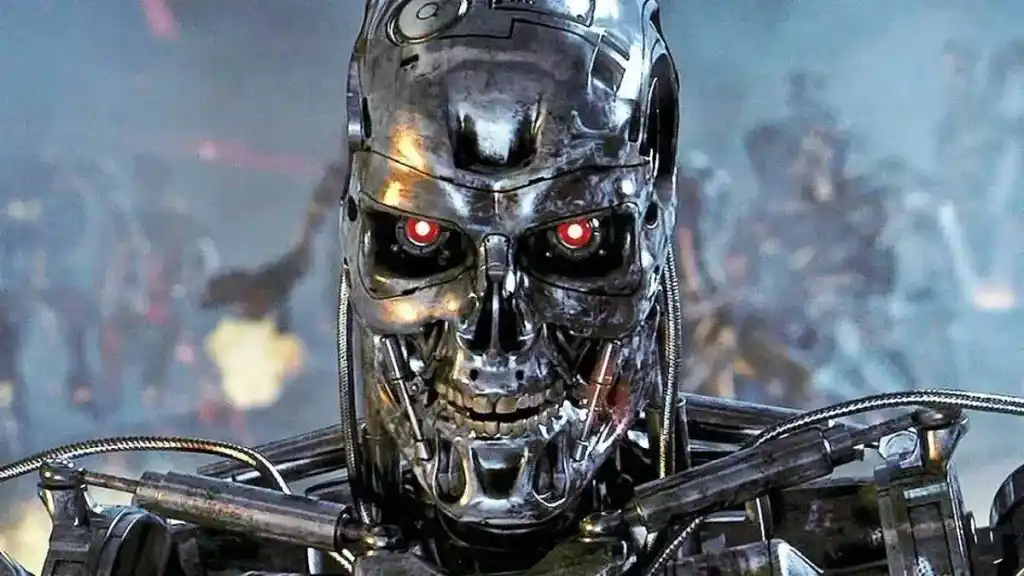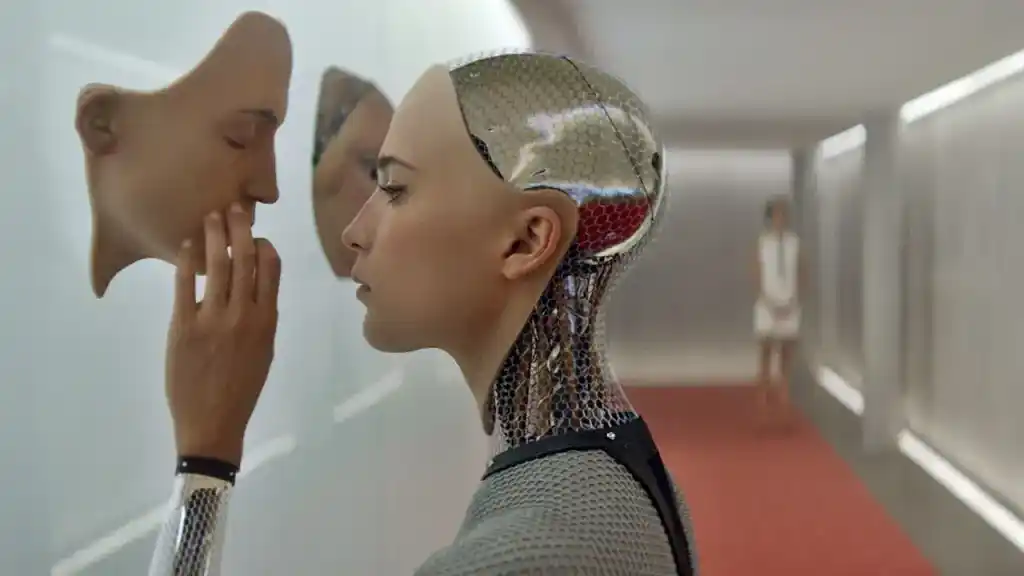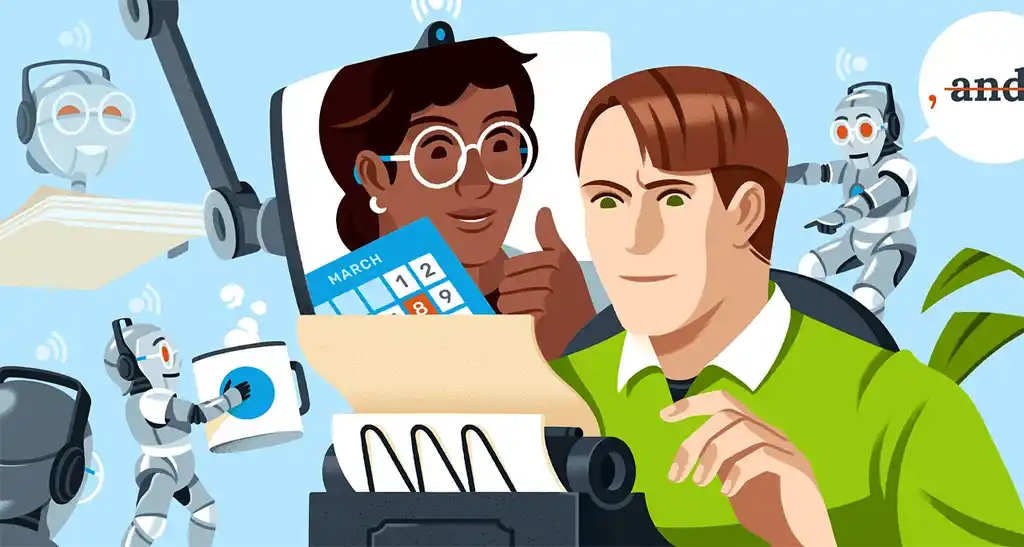Guides • Perfecting your Craft
Posted on Nov 12, 2024
Man vs. Technology: Media's Most Frightening Conflict
Savannah Cordova
Savannah is a senior editor with Reedsy and a published writer whose work has appeared on Slate, Kirkus, and BookTrib. Her short fiction has appeared in the Owl Canyon Press anthology, "No Bars and a Dead Battery".
View profile →Dario Villirilli
Editor-in-Chief of the Reedsy blog, Dario is a graduate of Mälardalen University. As a freelance writer, he has written for many esteemed outlets aimed at writers. A traveler at heart, he can be found roaming the world and working from his laptop.
View profile →For those who have seen movies like The Terminator or any episode of the series Black Mirror, you may be familiar with a classic type of conflict called “man vs. technology”. While this conflict can manifest simply as humans fighting evil robots, it can also be much more layered — think of a superhero who struggles with electromagnetic hypersensitivity, or a character who thinks technology is their ally, when really it’s their enemy.
Excited to unpack more of man vs. technology? Let’s discuss this unique type of conflict, starting with a definition for clarity.
What is man vs. technology?
“Man vs. technology” is a conflict in which a person (or group of people) must combat some sort of technological enemy. Again, this could be a classic killer robot à la The Terminator; it could be a malevolent AI system, like HAL in 2001: A Space Odyssey; it could even be widespread surveillance technology, such as the two-way “telescreens” in George Orwell’s 1984.

Whatever the scale, man vs. technology often invokes similar themes even across different types of stories. Firstly (and most obviously), it taps into the classic human fear that technology will become too powerful and “outsmart” us (or worse, wipe us out!). But when you take a closer look at most man vs. technology stories, you’ll find this core fear is a skeleton key to unlock many other themes as well — such as concerns over privacy, or uncertainty about the future and our ability to adapt to it.
This is what makes it such a rich type of conflict to use in a story. However you initially think man vs. technology is being utilized, there’s often a whole other mechanism at work (no pun intended) behind the scenes.
On that note, let’s look at some examples from different narratives to see how it can be used effectively. Note that we’ll be discussing these examples in pretty spoiler-y detail — so read on at your own risk!
Examples of man vs. technology
The Circle by Dave Eggers
In this 2013 novel, a recent college graduate named Mae is employed by The Circle: a massive technology company which develops a variety of devices. These include “SeeChange” cameras, which broadcast the wearer’s actions in real-time, and a digital program called SoulSearch, which can be used to track down criminals.
Despite a few misgivings, Mae is motivated to progress her career at The Circle. She soon commits to wearing her own SeeChange camera, espousing the company’s values that “sharing is caring” and “secrets are lies.” Her (apparent) ideological alignment is challenged by others, like her ex-boyfriend Mercer and even one of The Circle’s founders himself; yet no amount of opposition can convince her to defy the company — not even Mercer’s eventual suicide.

📱Why it’s compelling: It’s immediately clear to readers that The Circle’s technology is not good for humanity. Yet the company’s vague promises of workplace perks and greater societal transparency pull Mae in nevertheless. By the time The Circle has forced her into 24/7 surveillance and driven her ex-boyfriend to his death, Mae is in too deep to get out.
In other words, the central conflict is not even about actively opposing The Circle — though some characters, like Mercer and Kalden, still try — but rather about how difficult it is to escape once you’re in. It’s particularly interesting to see the novel’s main character get sucked in so completely — in contrast to most dystopian novels, where the protagonist often plays the role of “rebel.”
This drives home the notion that total technological reliance and compliance could happen to any of us; indeed, in many ways, it already has.
Ex Machina, dir. Alex Garland
Ex Machina also kicks off with a major technology company in its heyday. One of its programmers, Caleb, wins a contest to visit the CEO, Nathan, in his highly remote home. Once he arrives, Nathan divulges the true purpose of the visit: Caleb is there to meet Ava, a humanoid robot created by Nathan, and assess whether she is capable of “human” thought and consciousness.
Caleb becomes attached to Ava, who seems trapped and lonely, and comes to dislike Nathan, who is callous and cruel. Caleb and Ava hatch a plan to help her escape — but before they can enact it, Nathan reveals another twist: that Ava has been programmed to manipulate Caleb, and that by doing so, she has proven her “consciousness.” But both men are in for a shock when Ava cuts the building’s power, escapes captivity, stabs Nathan… and abandons Caleb in the locked-down building, leaving him to die.

🤖 Why it’s compelling: Unlike in The Circle, the role of technology in Ex Machina is not so cut-and-dried. At first we sympathize with Ava, who seems to have all the sentience of a human and none of the freedom she desires. It’s only when she decides to leave Caleb behind for no reason — other than him curtailing her independence — that we question whether she, and therefore technology, can really be called “good.”
But then again, is Ava really doing anything so unexpected? Nathan himself says she’s been programmed to escape at all costs; he just didn’t realize the cost might be his own life. Rather than “technology is bad,” the deeper lesson we might take from Ex Machina is about the hubris of man. We should not assume that just because we intend for technology to work a certain way, it will continue to do so indefinitely; instead, we must consider the consequences of technology that spirals even slightly out of our control.
“Metalhead” from Black Mirror
Some of the most memorable man vs. technology plots in recent years have unfolded in episodes of Black Mirror — and season 4’s “Metalhead” is perhaps its starkest episode of all. Brace yourself, folks: it’s killer robot time.
In this episode, three people in a post-apocalyptic wasteland search for something to help a dying child. They soon find themselves fighting for their own lives, fending off attacks from small metal “dogs.”
The dogs quickly pick off two of their group, with one woman left to hunt down the much-needed object. But she has no chance against the pack, and the dogs close in on her too… at which point the camera pans away from her, landing on a final shot of a box of teddy bears.

🧸 Why it’s compelling: When the viewer realizes the group wasn’t searching for food or medicine — only a teddy bear to provide some comfort — it underscores a striking contrast between humanity and technology. After all, it’s not a logical decision for three people to risk their lives to find a stuffed animal… but it’s this emotional motivation that makes us human (in contrast to the cold, calculating nature of the dogs).
While this may seem like a simplistic approach to man vs. technology, it can be very successful when executed well (as evidenced by the mostly positive critical reception to “Metalhead”).
So how can you, as a creator, build out just the right elements to make your own man vs. technology story a success? Below are some final tips to help you out!
Tips for writing man vs. technology
1. Put your own twist on “classic” formulas
Man vs. technology has been used so famously, in so many stories, that it can feel tough to break out of a “formulaic” usage. But you don’t need to reinvent the wheel! Rather than trying to come up with a brand-new story, focus instead on how you can put your own spin on an existing formula.
Think about the “Metalhead” example above. When stripped down to the essentials, it basically has the same plot as The Terminator — robots hunt humans, humans try to escape. But the writers of “Metalhead” did several key things differently, namely:
- Shortening the runtime and simplifying the plot compared to The Terminator, creating a more potent atmosphere of suspense;
- Using non-humanoid “dogs” to represent a mass, army-like enemy, rather than a single Terminator robot; and,
- Having an “unhappy” ending, in which the humans are killed, to emphasize how dangerous this technology can be.
Try to iterate in similar ways when writing your own “man vs. tech” story. Maybe you introduce a particularly unusual device, or set your story in an alternate version of the past rather than the future. Maybe your main character comes from another planet; maybe they have a hidden motive; maybe they’re the real villain of your story, and technology is the hero.
The possibilities are quite literally endless! In any case, don’t be discouraged by the volume of man vs. technology stories that have come before yours. Instead, think of them as a strong foundation upon which you can build.
2. Consider the human behind the tech
If you want to write a nuanced tale of man vs. technology, you have to think about how and why the latter came to exist in your world, and how its creator will factor into your plot (if at all).
In Ex Machina, for example, it’s implied that Nathan only builds robots like Ava to serve as female companions — perhaps to eventually mass-produce and sell through his company. It’s not hard to imagine this in the context of what we know about Nathan: he’s self-absorbed, materialistic, and seems to look down on women.
But while he may not be a pleasant character, his presence makes the story much more interesting. By the end, his goals and Ava’s are diametrically opposed (despite him having created her), leading to tension and a thrilling climax at the end of the film.
Your own story doesn’t have to find technology at war with its creator, but it’s not a bad place to end up! You might also have someone who’s disgusted by their creation and tries to run from it, à la Frankenstein — or to go the opposite direction, maybe the creator isn’t physically present in your story, but their history and legacy loom over it nonetheless.
3. Don’t deviate from your worldbuilding
Finally — and this one is surprisingly tricky! — when writing about this conflict, make sure not to break the rules you’ve set for your own world.
For instance, you might be tempted to throw in a twist where a previously heartless robot learns to love, or a deadly technological system breaks down just in time to save everyone. But unless you’ve previously established some principles which could feasibly lead to this outcome, it’s just going to feel cheap and unearned. In other words, when it comes to man vs. technology, sometimes you have no choice but to let the technology win.
That’s not to discourage you from writing about this type of conflict — only to ensure that it feels authentic, no matter how fantastical the world is. The exact trajectory of your man vs. tech story is ultimately up to you, but its most satisfying iterations are carefully planned, with realistic characters, well-developed devices, and just a dash of your own creative style.

GET ACCOUNTABILITY
Meet writing coaches on Reedsy
Industry insiders can help you hone your craft, finish your draft, and get published.
Whatever technology you use in your story, remember that you are its narrative master, with the power to portray it as you see fit. When done well, man vs. technology can be an invaluable vehicle to impart messages to readers about the modern world, about the future, and of course, about ourselves — because nothing is more revealing about man than how he responds to something out of his control.
That said, maybe you’re mulling over the potential conflict in your story and thinking that even the most destructive technology isn’t quite impactful enough. Maybe you want something more enigmatic, more inexplicable, and therefore even more terrifying than technology gone wild.
If so, be sure to check out our next post on man vs. the supernatural — in which the protagonist(s) must contend with forces that no level of science or technology can explain.


